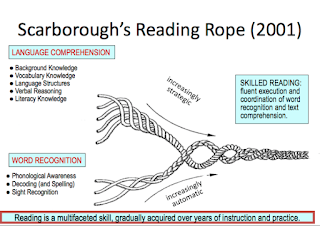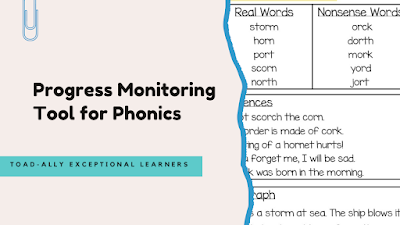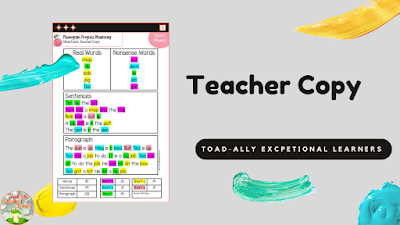Why Unlocking Vocabulary is Key to Bridging the Gap for Students
The hard thing about waiting three months for iReady's classroom diagnostic data is not knowing how students will do after 10 weeks of intervention.
My state and building use iReady diagnostics three times a year for READ Plans and intervention data. (more on come on iReady-both loves and dislikes)
As a special education teacher, I only use this data to compare students to their peer group and see what kind of gains they had over the year. (I have a whole blog post coming on how my building uses iReady.)
My building relies on this information to make predictions about State testing outcomes and interventions.
For me, I look at the overall gains my students make on the five categories assessed each time. This year, I made a huge shift to building and creating a solid foundation in phonemic awareness and phonics.
The macro data showed students made huge gains when using both Heggerty and Yoshimoto Orton-Gillingham. We lived in controlled decodable and built vocabulary through morphology.
What didn’t improve???
Student’s vocabulary
On iReady, students’ scores either dropped or maintained.
I’m the first to tell you that you should never, ever make significant instructional decisions on a single piece of data. It could take you off a cliff.
But if you layer in IEP goal data and it shows everyone either made or is on target to meet their goals well within their IEP cycle …
Could layering in something, not a change continue that growth????
Could it support and build students’ vocabulary and not have all the growth drop off???
Why Focus on Vocabulary
When I explain the five reading components to parents, I use a pyramid. Phonemic awareness and phonics are the base of the pyramid. With vocabulary and comprehension coming after. Fluency is needed across all.
To get to the top of the pyramid, word-level comprehension is needed before moving to sentence, paragraph, chapter, etc. You see where it goes.But what happens when you have weak word-level vocabulary????
What then? Let me explain how I landed here ...
All my phonics kiddos were placed in Orton-Gillingham. As the year progressed, the pacing of these groups slowed. In some cases stopping for a week or so on a concept, or phonogram or just working to get them unconfused. (English is so confusing.)
As lessons got more complex and the more layers students had to work with the more, I noticed other holes. Looking back at my lesson notes and comments about student progress within lessons it became more obvious that vocabulary was one thing students were struggling with.
To be clear, I'm not talking about Tier 3 subject-specific words. I'm talking about Tier 1 words--like chair, boil, broil, etc. (here is my previous post on Vocabulary Tiers)
Yes, about half of those I pull for OG do receive pull-out language support from a Speech-Language Pathologist.
The funny (or head-banging) thing about all their iReady Vocabulary score was the “can dos” all said to teach 5 words and all through read-aloud. (This is a great idea for classroom teachers; not so much for specialists.)
What Does the Research Say
The Science of Reading (SoR) is an evidence-based approach to teaching reading that is grounded in research from cognitive psychology, linguistics, and neuroscience. It emphasizes the importance of systematically teaching foundational skills to help students become proficient readers. One crucial aspect is phonemic awareness, which involves recognizing and manipulating individual sounds in spoken words.
By explicitly teaching students to understand the connection between letters and sounds through phonics instruction, they can decode words and read fluently. It's essential to provide activities that engage students in segmenting, blending, and manipulating sounds in words to strengthen their phonemic awareness and phonics skills.
Phonemic awareness refers to the ability to identify and manipulate individual sounds in spoken words. It is a critical skill that helps students understand the connection between letters and sounds. Phonics instruction teaches students the relationship between letters and sounds, enabling them to decode words and read fluently. Teachers should provide explicit instruction in these skills, using activities that involve segmenting, blending, and manipulating sounds in words.
Fluency is the ability to read accurately, quickly, and with expression. It is developed through repeated practice and exposure to a wide range of texts. Teachers can support fluency by providing opportunities for independent reading, modeling fluent reading, and using strategies like echo reading or choral reading. Vocabulary instruction is also crucial for reading comprehension. Teachers should explicitly teach new words, provide context clues, and encourage students to use strategies like word analysis and context to understand unfamiliar words.Comprehension involves understanding and making meaning from text. Teachers can support comprehension by explicitly teaching strategies such as predicting, questioning, summarizing, and making connections. These strategies help students engage with the text, monitor their understanding, and make inferences. It is also essential to promote metacognition, encouraging students to think about their thinking and monitor their comprehension. By incorporating these strategies into instruction, teachers can help students become active and proficient readers.
What Does this Mean
SoR and Scarborough's Rope Model of Reading bring a new light to an old question surrounding phonics and vocabulary. The question is how to layer something in that doesn’t take away from the gains students have made.
I don’t know why this group of students have a weak vocabulary. I could blame COVID–these students were remote and hybrid during COVID. It could be the lack of direct, explicit instruction surrounding Tier 1 and Tier 2 vocabulary. Or it could be the lack of helping students make connections to previously taught vocabulary to new words.
Coming this semester, I’ll share how I plan to attack this and build students’ Tier 1 and Tier 2 vocabulary. I hope to find actionable, tangible ways for students to make gains that don’t take tons of time to get the most bang for my buck as a special education teacher all while doing my job as their special education teacher.
Chat soon-
What I use to help me make Data Driven Decisions
I was wrapping up my post-observation meeting with my principal and data came up. He asked, “How did I come to the decision to teach what I did?”
So, I pulled out a copy of my Assessment Data Analysis. I love LOVE using this form. {Catch the video to see how I fill it out and grab your own copy.}
The cool thing about this form is the power, control, and guidance it gives you over your data. It is also open-ended enough to use any pre-assessment you want. Well, within reason.
The data I used was from my Orton-Gillingham groups, their most recent pre-test from my Phonics Progress Monitoring. I assessed them using the Short Vowel Mixed Digraphs.
This Phonogram Progress Monitoring can be used as a Pre and Post assessment.- Teacher Evaluations
- RTI/MTSS Body of Evidence
- Monitoring Progress of Intervention groups
- Mirco IEP Goal Progress
Assessment Data Analysis
This Data Analysis is perfect for RTI/MTSS interventions and Special Education groups or if you have to provide data as part of the teacher evaluation–like me. Bonus administrators love it as you have your thinking right there on paper.
I use this ALL the time. I keep it in each group's binder. This doesn't replace IEP goal progress monitoring but it gets me out of the weeds. I think most of us in Special Education we get caught up in the microdata a little too much and forget to come up for air.
This form allows me to see the group data from a balcony view. Just like my Phonic Progress Monitoring--I can break down where a student is struggling and differentiate my lesson to target more nonsense words or more sentence fluency work or more controlled contented text.
I love that I can catch any misconceptions right from the beginning and not later as I address vowel confusions.
This year part of my professional goal has been to find a way to track growth/mastery using Orton-Gillingham to make having grade-level skill carry-over conversations easier. I don't know about you but my classroom teachers they like to see the data before they make decisions. [I love this as this has been a HUGE RTI and intervention push!!]
I used my Phonics Progress Monitoring Tool.
A couple of important things about my Phonics Progress Monitoring tool
- Yes–I use an Orton-Gillingham scope & sequence to provide explicit phonics instruction to my student education goals but it’s TOTALLY OKAY if you don’t. It will still HELP you determine if students have mastered the phonics phonogram in question.
- It will work with ANY phonics scope and sequence--from Core to Special Education
- This product is bottomless and growing--grab your before it grows
How to Fill out the Assessment Data Analysis
This video will show you how I filled out the form using my Phonics Progress Monitoring Tool but it can be used with any assessment.
Pick an assessment that can be used as a pre-test or baseline and something that is short-lived. Like your next math unit on double-digit addition or subtraction, or next grammar unit or your next phonics unit. Unit quizzes work–just pull something towards the end of the unit or subject. This will help you establish a baseline on most if not all of the standard you will be teaching. (I try to keep mine to either a page or less than 10 questions.)
To use this form you don’t need to have multiple teachers using it.
Give the assessment and grade.
Establish and define Mastery. AKA: what’s that score that tells you the student’s “got it.” (Most of the time I go with 80% but it depends on the skill. For my phonics work, I establish mastery at 90%.) Write down whatever you decide. It will not change for this round.
Starting on the Pre-Assessment side: fill out the date, Unit and Standard(s), Length of the unit (I have found making this less than 5 days sets everyone up.), and Big Ideas.
Moving down the form: add teacher(s) name, the total number of students who took the assessment, the number and percent of students proficient and higher, and the number and percent of students not proficient.
The last three boxes will have student names. This is where you need to know your students and the material that is going to be taught.
First of the last three: write down the names of the student(s) who will likely be proficient by the end of the instructional time meaning those students who are close to proficient.
In the second to last box write the names of the student(s) likely to be proficient by the end of instructional time but who have far to go.
In the last box, write the names of students who will likely not be proficient by the end of the instructional time. These students will need extensive support.
Let me show you how I make this work with a group of students I provide explicit phonics instruction too.
Using this form to make data decisions will help you move your students. Remember: Data doesn't judge. It is what it is. Yes, even my data sucks but it is also a place to start. When I do progress monitoring, I always have someone who asks if it's a test. My answer is always the same. "No. It tells me what we need to work on. What do I need to do to help you."
This is one way to look at data. I'd love to hear how you look at your data.
Chat soon,
PS. Make sure to grab a FREE sample.
Phonics Progress Monitoring
Grab your FREE Digraphs Phonics Progress Monitoring Sample to explode your student's phonics growth.
Thank you!
You have successfully joined our subscriber list.
How I use games to increase students' phonics word level fluency
I sat with my grade level team, reviewing this month’s oral reading fluency data and they could not stop asking me how I moved my group.
In a word – games.
The team had decided to work on accuracy instead of words correct. (I’m not sure there is a great way to increase reading fluency but okay I’m in.) Sometimes starting small is way better than not starting at all and this group has never ventured into the world of using one's data for anything.
So…
This year, grade-level teams are working with our Coach to create monthly data-based goals. We just started using Benchmark Advanced, so teams are looking at all the reading data and making a decision on a long and short-term plan. (For most of the teams I work with–this is the 1st time they have really looked at and done anything with their classroom data.)
This one, as much as I’m shaking my head, I can see a place where I can layer in additional fluency work at the word level with their students and not sacrifice fidelity.
Over the years, I have moved the oral reading fluency scores in a variety of ways. I have never found something that works with most of the students I support for reading. From repeated readings to focusing on specific words, nothing works for all the students in a group.
All my reading groups this year are OG. I live and breathe OG, which means there is a precise lesson plan and very little room to add “other” things. I’m not sure how many really get this. This year, teachers want me to fix everything.
I use Yoshimoto. I really love the flexibility it gives me. I dislike the amount of flexibility it gives me but I can lay out each group's scope and sequence and add my “others” as I need to. Mind you within reason.
Last year, I began working in very specific game days to target word-level fluency. These days tended to be on Fridays (aka Fun Friday). When a Game Tub in tow, students played Crocodile Dentist and Squeaky Squirrel.
Slowly, the sounding out loud stopped. The confidence in the learning target increased. Slowly, the syllable understanding increased. And then the accuracy scores changed. Then the big daddy of them all, the iReady Phonics scores started to move.
Now, was this all by adding game time to their practice do this. I have no way of knowing. But what I do know is that if students are engaged and motivated then everything falls into place.
Reflecting on this growth over the summer, led me to add phrases and sentences based on the skill being taught. You can find my game pieces in my store to begin building self-confidence, language skills, and word-level fluency in your students.
My students do have their favorites but I make a point to rotate them about every month.
The cool thing about all of the game pieces is that it is super easy to differentiate the cards depending on who is in the group and what each student needs to work on.
Nothing like being able to stack the deck. lol
ROAR–CVC, CCVC, CVCC is built using pictures to support the words from Smarty Symbols but you also get cards with no pictures.
You can play with just CVC or CVCC with and without pictures.
OR
When I have a group working on Five and Six sounds. I pull out Melt. Then students can work on real and nonsense words. You can add easier words to build fluency or a couple of compound words to make it more interesting.
OR
Click on any picture to check them out for yourself. Your students will love any of them.
What games do your students like to play?
Chat soon,
Feeling unsure about a student's phonics level? This new resource will instantly help
Have you ever sat in a meeting reviewing phonics data and someone asks if the student has mastered reading digraphs because the student doesn't demonstrate this in their small group?
Whether in an RTI meeting or just reviewing the data, this information helps plan the student's specific next steps.
If your phonics program is like mine--it didn't come with a quick way to progress monitor a student after you have taught a sound (phonogram). And sometimes you need more than dictation and how they read in the last decodable text.
You need more than a gut check BUT you need a number to prove what the student knows.
This Progress Monitoring Tools for Phonics solves this problem. It's quick and super easy to give after you have taught a sound. You can learn if students can read the phonogram at the word level (real & nonsense), sentence level, or in a paragraph with controlled text.
I use this Phonics Tool as a pre/post with mixed sounds. This has a very specific set of sounds such as all short, all R-controlled or all digraphs. Then I can teach the sounds in the pattern, reassess and have the data to prove if they have it or not.
The teacher's copy of the tool is colored-coded to make it super easy to score and make decisions about what to do next. This progress monitoring tool can be completed by teachers, para-professionals, or volunteers.
Each phonogram has its own page and you can find it again on a mixed pattern page. I have made the Phonics Progress Monitoring Tool paperless as well. It can be used with Google. The link is within the product.These sheets can be completed are perfect for small targeted groups and are a perfect addition to any Orton-Gillingham Practice or Phonics Intervention.
You can expect updates throughout the year including Vowel teams, Suffixes, -ng & -nk, and more!!
Grab your today before the price increases!
Chat Soon,

About Me
Resource Library
Thank you! You have successfully subscribed to our newsletter.



.png)

.png)














